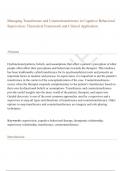Overig
Managing Transference and Countertransference in Cognitive Behavioral Supervision: Theoretical Framework and Clinical Application
- Vak
- Instelling
Managing Transference and Countertransference in Cognitive Behavioral Supervision: Theoretical Framework and Clinical Application
[Meer zien]



